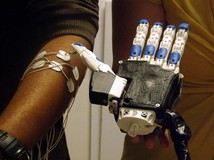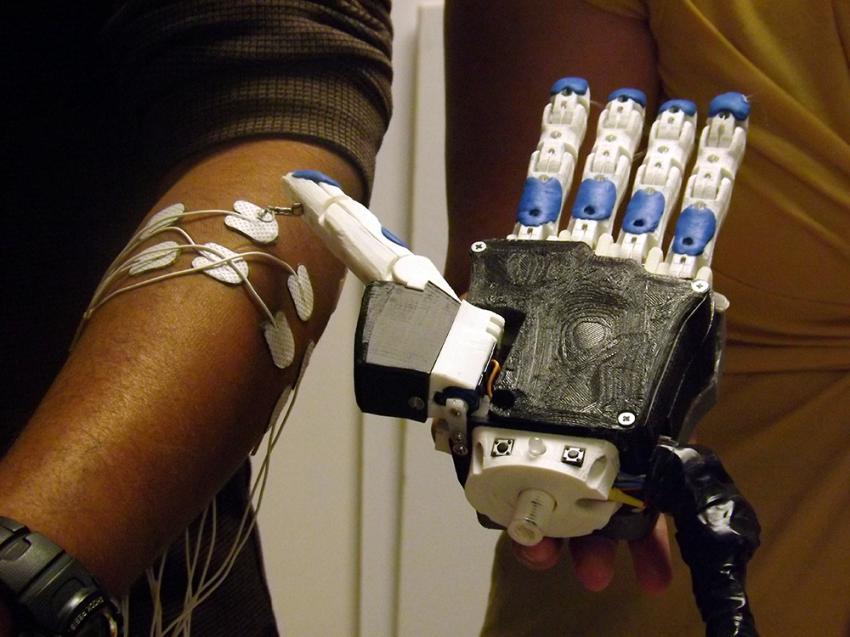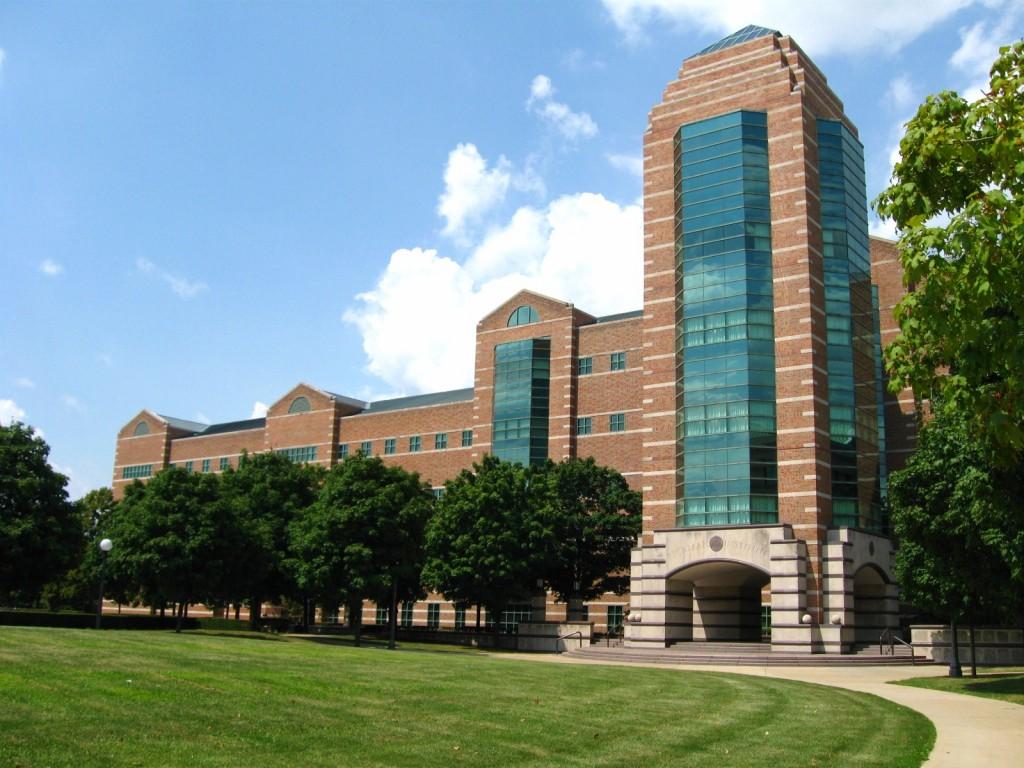/ News

Illinois Students Target with 3D Printed Hand Which Learns Users’ Movements
Here we go again! Another story about a 3D printed prosthetic hand. It seems as though every few days there is another interesting new 3D printed prosthesis coming about; whether it is a 3D printed Iron Man hand or a 3D printed myoelectric hand, there is never any dull moment in the 3D printed prosthesis space.
Today we learn of yet another 3D printed prosthetic hand, but this one is even more unique than the others that we have covered in the past. A group of students at the University of Illinois at Urbana-Champaign have come up with a device which they hope will bring affordable prostheses to developing nations such as Ecuador.
The newly designed 3D printed prosthetic hand has the ability to recognize patterns in a user’s movement. Not all individuals who have lost a hand are alike. Some have a portion of their wrist still intact, while others are missing a larger portion of their arm as well. This new hand features a machine-learning algorithm which allows it to do more than the traditional prosthetic hand is capable of. Instead of only being able to open and close, it can learn the other positions of the hand, making it far more functional.
“Using the machine-learning algorithm based off the signals it picks up from the muscles, it can figure out which of these grips he is actually doing,” explained team leader Aadeel Akhtar, an MD/PhD candidate in neuroscience from the College of Medicine at Illinois to phys.org. “The microcontroller with the machine-learning algorithm will then replicate the grip he’s trying to make. Based on those signals, it sends commands to motor drivers, which churn the motor and make the hand move.”

Credit: Mike Koon, University of Illinois
One of the great advantages of using 3D printing to create and customize these individual hands is the fact that they cost a mere $270 to create. Compared to the price that traditional myoelectric prosthesis costs (upwards of $30,000), this provides a means for a solution in developing countries.
In fact, back in August, Aadeel Akhtar and master’s student Mary Nguyen, made their way down to Ecuador to try their creation out on a man in need of a prosthetic hand. “The goal of the trip was to get it to work with a patient,” Akhtar explained. “Although it took some debugging, we were successful.”

This model of 3D printed hand takes approximately 30 hours to print out, and an additional two hours to assemble. It features all the needed electronic components in order for it to convert neural signals into movements. It only takes a few minutes to program the hand to work with a particular patient, and it is capable of five different hand movements: open hand, resting hand, closed hand, a fine pinch, and a three-finger grasp.
“We did some initial experiments in the lab and found that with only six minutes of training, users could distinguish between six different grips with 88 percent accuracy without looking,” said Akhtar. “With that kind of result, imagine how well someone could operate it in even a week’s time.”
The team isn’t done yet though. They plan to advance this technology even further by modifying the dynamics of the hand. They also plan on creating a more intricate system of movement as well as adding in some other almost science fiction-like abilities.
“No commercial prosthetic device has any sort of feedback,” Akhtar explains. “We’re going to put sensors in the fingers. Based on the amount of force that the fingertips are detecting, we are going to send a proportional amount of electrical current across your skin to stimulate your sensory nerves. By stimulating your sensory nerves in different ways with different amounts of current, we can make it feel like vibration, tingling, pain, or pressure. Through a mechanical connection from one of the artificial fingers directly to the skin, the patient will also be able to better feel the position of their hand without looking at it.”
It is amazing how only two years ago the prospect of 3D printing prosthetic hands was hardly even conceived. Now we are looking at the creation of devices that can do so much more than their more traditional predecessors, at prices comparable to a routine doctors visit.
What do you think about this latest technology within the field of 3D printed prosthetic hands? Will it lead to the availability of these devices to everyone in need? Discuss in the 3D printed learnable prosthetic hand forum thread on 3DPB.com.
[Source: phys.org]
Source: http://3dprint.com/22126/learnable-3d-printed-hand/
/ About us
Founded by Russian entrepreneur Dmitry Itskov in February 2011 with the participation of leading Russian specialists in the field of neural interfaces, robotics, artificial organs and systems.
The main goals of the 2045 Initiative: the creation and realization of a new strategy for the development of humanity which meets global civilization challenges; the creation of optimale conditions promoting the spiritual enlightenment of humanity; and the realization of a new futuristic reality based on 5 principles: high spirituality, high culture, high ethics, high science and high technologies.
The main science mega-project of the 2045 Initiative aims to create technologies enabling the transfer of a individual’s personality to a more advanced non-biological carrier, and extending life, including to the point of immortality. We devote particular attention to enabling the fullest possible dialogue between the world’s major spiritual traditions, science and society.
A large-scale transformation of humanity, comparable to some of the major spiritual and sci-tech revolutions in history, will require a new strategy. We believe this to be necessary to overcome existing crises, which threaten our planetary habitat and the continued existence of humanity as a species. With the 2045 Initiative, we hope to realize a new strategy for humanity's development, and in so doing, create a more productive, fulfilling, and satisfying future.
The "2045" team is working towards creating an international research center where leading scientists will be engaged in research and development in the fields of anthropomorphic robotics, living systems modeling and brain and consciousness modeling with the goal of transferring one’s individual consciousness to an artificial carrier and achieving cybernetic immortality.
An annual congress "The Global Future 2045" is organized by the Initiative to give platform for discussing mankind's evolutionary strategy based on technologies of cybernetic immortality as well as the possible impact of such technologies on global society, politics and economies of the future.
Future prospects of "2045" Initiative for society
2015-2020
The emergence and widespread use of affordable android "avatars" controlled by a "brain-computer" interface. Coupled with related technologies “avatars’ will give people a number of new features: ability to work in dangerous environments, perform rescue operations, travel in extreme situations etc.
Avatar components will be used in medicine for the rehabilitation of fully or partially disabled patients giving them prosthetic limbs or recover lost senses.
2020-2025
Creation of an autonomous life-support system for the human brain linked to a robot, ‘avatar’, will save people whose body is completely worn out or irreversibly damaged. Any patient with an intact brain will be able to return to a fully functioning bodily life. Such technologies will greatly enlarge the possibility of hybrid bio-electronic devices, thus creating a new IT revolution and will make all kinds of superimpositions of electronic and biological systems possible.
2030-2035
Creation of a computer model of the brain and human consciousness with the subsequent development of means to transfer individual consciousness onto an artificial carrier. This development will profoundly change the world, it will not only give everyone the possibility of cybernetic immortality but will also create a friendly artificial intelligence, expand human capabilities and provide opportunities for ordinary people to restore or modify their own brain multiple times. The final result at this stage can be a real revolution in the understanding of human nature that will completely change the human and technical prospects for humanity.
2045
This is the time when substance-independent minds will receive new bodies with capacities far exceeding those of ordinary humans. A new era for humanity will arrive! Changes will occur in all spheres of human activity – energy generation, transportation, politics, medicine, psychology, sciences, and so on.
Today it is hard to imagine a future when bodies consisting of nanorobots will become affordable and capable of taking any form. It is also hard to imagine body holograms featuring controlled matter. One thing is clear however: humanity, for the first time in its history, will make a fully managed evolutionary transition and eventually become a new species. Moreover, prerequisites for a large-scale expansion into outer space will be created as well.
Key elements of the project in the future
• International social movement
• social network immortal.me
• charitable foundation "Global Future 2045" (Foundation 2045)
• scientific research centre "Immortality"
• business incubator
• University of "Immortality"
• annual award for contribution to the realization of the project of "Immortality”.



 LinkedIn
LinkedIn
 LiveJournal
LiveJournal
 Google
Google
 Twitter
Twitter
 Facebook
Facebook
 Я.ру
Я.ру
 ВКонтакте
ВКонтакте
 Mail.ru
Mail.ru